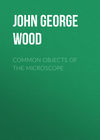Buch lesen: «Hardy Perennials and Old Fashioned Flowers», Seite 15
Hepatica Angulosa
Nat. Ord. Ranunculaceæ
This is a very distinct species. It comes from North America, and is twice the size of H. triloba in all its parts; the leaves are more cut, and very woolly; the flowers are bright mauve, and 1½in. across. All the Hepaticas are slow growers, but H. angulosa is the more vigorous. Some say they should be grown in peat, but I never saw them so fine in peat as in strong loam, well drained and manured; they are the better with slight shade. I do not object to peat, as possibly it may be more suitable than the natural soil of some gardens. Still, if I had to make up a compost for Hepaticas, I should freely use strong loam on a well-drained site. With me they have been in flower nearly three months, commencing in February.
It seems desirable to increase these fine spring flowers, but they are most impatient of being disturbed, and, after all, the increase can exist in no finer form than in big clumps, though when they are to be propagated the roots should be divided before the new leaves are produced, which is during the blooming period. A deeply-dug and well-manured plot should be prepared for them, and their long roots should not be doubled up in the least; they both need and deserve great care.
Flowering period, February to April.
Hepatica Triloba
Syns. Anemone Triloba and Anemone Hepatica; Nat. Ord. Ranunculaceæ

Fig. 50. Hepatica Triloba.
(One-third natural size.)
The well-known common Hepatica, of which there are so many beautiful varieties. It is a hardy perennial, one of the "old-fashioned" flowers of English gardens, and is said by some to be a British species; anyhow, it was well known and admired in this country 300 years ago. Well-established specimens form neat tufts of three-lobed leaves on long stems, which are not evergreen in this climate, though the Hepaticas are known to be so in North America, one of their most extensive habitats. Here, under cultivation, they produce much finer flowers, and more of them. The cut (Fig. 50), however, shows the foliage in more perfect form than it is commonly seen to be in this climate during the period of bloom, when the old is usually sered, and the new scarcely visible. The varieties of H. triloba differ only in the colour and form of their flowers, there being blue, purple, white, and pink. Of the first and last named there are double varieties as well.
Cultivation, the same as for H. angulosa.
Flowering period, February to April.
H. t. splendens is a charming Windflower, and one which, from its extra brilliancy, is sure to become a favourite, as, indeed, the whole genus Anemone is. It is a new variety of H. triloba, and is yet somewhat scarce, differing from the more generally known kinds of the same species in only two points, so that, beyond the mention of them, no other description is needful: (1) Its flowers are single red, but so much deeper in colour, brighter, and of better substance, as to be quite distinct, and merit the name "splendens." (2) It flowers earlier than the commoner red kind. This handsome seedling of the common Hepatica is very suggestive of what can be done by raising seed from carefully-selected sorts, and within the last few years something has been done in that direction, so that in a little time we may expect to see other good varieties. I may add that seedlings are three years before they bloom, and even longer before a proper idea can be formed of their qualities.
Cultivation, the same as for H. angulosa.
Flowering period, February to March.
Hesperis Matronalis Flore-pleno
Double Sweet Rocket, or Dames' Violet; Nat. Ord. Cruciferæ
There are several double forms of this very popular old flower, such as purple, ruby, and pure white, the last named being by far the greatest favourite. A few years ago it was said to be very scarce, and in some parts of the country it certainly was so, but when the present taste for the good old flowers became general, it was not only found, but quickly propagated, so that now the double white Sweet Rocket may be had everywhere, and certainly no more beautiful flower can occupy the garden borders, its perfume being strong and deliciously fragrant. The parent plant of these double kinds is widely distributed over Europe; all are perfectly hardy.
They vary in height from 12in. to 18in., branching candelabra-like, the flowers being produced in terminal spikes, arranged in the way of, and very much resembling, the double stocks—in fact, the Hesperis used to be called "Queene's Gilloflower." The leaves may be briefly described as oval, lance-shaped, toothed, and veined; dark green, and often spotted or blotched. Gerarde's description, too, may be given, as it is always pleasant to recognise the old plants of 300 years ago: "Dames' Violets hath great large leaues of a darke greene colour, somewhat snipt about the edges; among which spring up stalks of the height of two cubites, set with such like leaves; the flowers come foorth at the toppe of the branches—like those of the Stock Gilloflower, of a verie sweete smell."
These desirable flowers have a long blooming period, and their cultivation is simple; there is, however, one special point to be observed, otherwise these double kinds will die off. It should be remembered that they produce no seed, and propagation must be carried out by divisions of the roots and cuttings; old plants, too, have a habit of forming their perennial crowns nearly out of the soil, so that the roots going down from them are often bare and unestablished; the older parts, too, are frequently attacked by ground vermin. No doubt these causes would tend greatly to the former scarcity of the finer kinds, but all the difficulties, if they can be called such, may be overcome by the very simple process of either putting in cuttings like wallflower slips during summer, or, as soon as the old plants are past their best bloom, dividing and replanting the various parts deeper, whereby all of them, however small, will make good plants the following season.
This mode of keeping up the stock will be found to make the plants vigorous and free blooming, and also will prove a remedy for the complaint so often given expression to in such words as "I lost all my double Sweet Rockets; I cannot keep them above two years."
Flowering period, June to August.
Heuchera
Alum-root; Nat. Ord. Saxifragaceæ
This is a small genus of hardy perennials suitable for the decoration of the English garden from their bold and finely-shaped leaves, which are well marked with various pleasing tints, also because of their perpetual verdure and neat habit. It takes its name from J. H. de Heucher, a botanist. The species, as many of them as are known, are from American habitats; nearly all have been introduced within the last sixty years; the well-known H. Americana, however, is an old plant in English gardens, having been cultivated for 223 years. The order, as given above, together with the illustration figuring one of the species (see Fig. 51), will give some idea of the usefulness of the genus, especially when it is remembered that in the depth of winter the foliage is fresh, and even in a growing state.
The flowers are of little value for ornamental purposes; they are very small and numerous, and are arranged in panicles or racemes, on rather tall and mostly leafless stems, round, and somewhat wiry; calyx, petals, and stamens have a mixed appearance, the whole flower being of a dingy colour, often resembling some of the panicled bloom of meadow grass, when seen at a short distance; the calyces, however, are persistent, they crown the capsules; these and the naked stems, from their durable nature, mar the beauty of the foliage for several weeks, unless cut off. The plants are more ornamental without the flowers, as they impart a seedy appearance; at no time does the foliage show to more advantage than in January, when most herbaceous plants are dormant, and when their handsome tufts are alike beautiful, either bedewed with fogs, crystallised with hoar-frost, or glittering in the sunshine. As a genus, Heuchera is sometimes placed after Saxifraga and before that of Tiarella; the latter it much resembles, as well as the genera Mitella and Tellima. Anyone knowing these will at once admit the usefulness of the plants under notice.
Not only do they make good edgings or lines to borders, but the leaves in a cut state are of great service for table decoration, doing duty repeatedly around dishes, &c., either with or without flowers; after being so used, if placed in water, they may be kept a fortnight in good form. I am told that the leaves are sold in Covent Garden Market for similar purposes. I have seen them used in the autumn with the large white anemone, and in winter with the Christmas rose, one flower arranged and tied on the face of a single leaf. These placed round dishes, &c., have a pretty effect.
They grow freely in any kind of soil, excepting stiff clay, and are readily increased by division of the crowns. This may be done any time, but, perhaps, spring is the best.
The Heucheras bloom from May to August.
Heuchera Americana
American Heuchera; Nat. Ord. Saxifragaceæ
The flowers of this species are a dull or reddish purple. The foliage is rough and clammy; the form of leaf resembles that of H. glabra (see Fig. 51), but the colour is a lighter green. All the genus are of an astringent nature, but this species is remarkably so, and in its native country has earned for the family the name of "Alum-root."
For cultivation and flowering period see Heuchera.
Heuchera Cylindrica
Cylindrical-spiked Heuchera; Nat. Ord. Saxifragaceæ
This is much in the way of H. Richardsoni, with the distinction indicated by the name, the flowers being arranged evenly round the spike like a cylinder.
For cultivation and flowering period see Heuchera.
Heuchera Drummondi
Drummond's Heuchera; Nat. Ord. Saxifragaceæ
A tall kind, with leaves of handsome shape (heart-shaped and lobed) and greener than most varieties.
Cultivation and flowering period are described under Heuchera.
Heuchera Glabra
Smooth Heuchera; Nat. Ord. Saxifragaceæ

Fig. 51. Heuchera Glabra.
(One-sixth natural size.)
This was introduced in 1824 from North America. The foliage is bold and abundant; the illustration (Fig. 51) not only gives a good idea of the form and habit of foliage, but fairly represents the whole genus, as seen during the late (1882) season. This species has dull pinkish flowers; the scapes have a few leaves; root leaves are 2in. to 5in. in diameter, heart-shaped, lobed, toothed, smooth, and of a dark bronzy-green colour. The leaf stalks are long and slender; the habit very neat.
Cultivation and flowering period are described under Heuchera.
Heuchera Lucida
Shining-leaved Heuchera; Nat. Ord. Saxifragaceæ
A very dwarf species, not more than 3in. or 4in. high; the foliage a clear bright green, nearly kidney-shaped, lobed, and roundly toothed. The fresh appearance of its prostrate leaves, which are 2in. across, forms a pleasing object in mid-winter.
Cultivation and flowering period, as given under Heuchera.
Heuchera Metallica
Nat. Ord. Saxifragaceæ
This was presented to me in 1881 by a lady, who informed me that it was introduced by the late Miss Hope. It is a beautiful plant; the hues somewhat justify the name, but to the touch the leaves are more like a soft fabric, as cloth or velvet. The flowers are of no value, but the foliage is bloom of no mean order, so much so, that everyone stops to admire this handsome plant.
Cultivation and flowering period, as given under Heuchera.
Heuchera Micrantha
Small-flowered Heuchera; Nat. Ord. Saxifragaceæ
From Columbia. Flowers a yellowish-green; leaves nearly round, bluntly lobed, crenate or round toothed, the teeth horned or pointed; the colour is inclined to auburn during autumn, but it varies, and for a botanical description it would be hard to state a particular colour. The gardener, however, will find in this a most useful plant, where different forms and tints of foliage are desirable. Into the sub-tropical garden it may be introduced with good effect. I may add that the leaf stalks are 9in. to 12in. long, also of a rich brown colour, and the leaves are 3in. to 5in. across.
Cultivation and flowering period, as described under Heuchera.
Heuchera Purpurea
Nat. Ord. Saxifragaceæ
This seems to be a less known or newer variety. If the name has reference to the colour of the foliage, it is not inappropriate. The bold leaves are a dark green, shading to a bronze, then a purple, the whole having a soft downy effect. It is a charming kind.
Cultivation and flowering period, the same as for the Heuchera.
Heuchera Ribifolia
Currant-leaved Heuchera; Nat. Ord. Saxifragaceæ
This is another dwarf kind, producing such leaves as the name denotes. Of this species the only useful feature for a garden seems to be its habit of neatly carpeting the ground under deciduous trees. It has also a remarkably fresh appearance during winter.
Cultivation and flowering period, as for other Heucheras.
Heuchera Richardsoni
Richardson's Heuchera; Nat. Ord. Saxifragaceæ
A taller variety than H. Drummondi. The most striking distinctions are the pale green colour of the young leaves contrasting with the bronzed appearance of the older ones, and the larger size of its flowers, which, however, are green.
Cultivation and flowering period, as for other species.
Houstonia Cœrulea
Bluets; Nat. Ord. Gentianaceæ

Fig. 52. Houstonia Cœrulea.
(Natural size.)
Hardy and evergreen. This pretty little shining plant never exceeds a height of 3in. Like most species of this order, both flowers and foliage have much substance and endure for a long time in perfection, but its neat form and bright parts most commend it—it almost sparkles in both leaf and flower. This species, as implied by the specific name, bears a blue flower, but there is a variety (H. c. alba or H. albiflora) which bears white flowers, from a specimen of which the illustration (Fig. 52) is drawn, and, as the colour of the flower is the only dissimilarity, a description of the typical form will in all other respects apply to both.
The flowers, which are produced singly on slender stems 2in. high, are composed of a four-toothed calyx; corolla, four petals, or four-toothed and funnel-shaped; when fully expanded each flower is ½in. across, and shows a distinct yellow eye. The leaves of the root are spathulate, those of the stems opposite and lanceolate; all the parts are shown of the natural size in the illustration.
All the known Houstonias are natives of North America; still, our winters seem to kill strong plants. From an impression that the plants were destroyed by insects amongst their roots and foliage, I had several tufts lifted, well shaken out, and divided in the autumn; they were replanted in leaf soil and sand and kept rather moist. When planting them, all amongst the roots was thickly strewn with dry silver sand, so as to leave no space for the lodgment of vermin; the results were fine, fresh, green tufts throughout the following winter, which, however, was not severe; still, the plants not so treated dwindled and were unhealthy, whereas the others were finely in bloom, the subject of the drawing being one of them. These minute plants do well and look well wedged between large stones on rockwork, where they flower nearly all the year round; they also form pretty pot specimens under cold frame treatment; and they may be used with good effect for surfacing the pots in which other hardy but tall and bare stemmed things—such as lilies—are grown.
The mode of propagation has been indicated by the above autumnal treatment.
Flowering period, April to July.
Hutchinsia Alpina
Syn. Lepidium Alpinum; Nat. Ord. Cruciferæ
An alpine species, from South Europe, which may be said to be evergreen in this climate, and, according to my experience of it, flowering throughout the year. Though found in some gardens to be difficult to establish, when it finds a suitable home it becomes a pretty addition.
This alpine seldom exceeds 2in. in height. The flowers are a glistening white and very small, produced in numerous heads, and they are very enduring; the calyx is concave and falls off; the four petals are inversely ovate; the little leaves are deeply lobed, of a pale shining green colour, with plenty of substance; its habit is spreading or creeping. Neither slugs nor any other pests seem to meddle with it. It may be transplanted at any time, and the mode of propagation may be gathered from the following remarks.
Probably because its name implies its alpine character, some may be misled to plant it on rockwork; whether that be so or not, I so tried it, and found it would not grow in such a situation. A bed of dwarf and moisture-loving subjects was being planted, in which a bit of this Hutchinsia was dibbled, and it found a home in the moist vegetable soil. For two or three years I do not remember to have seen it, or the seedlings, without flowers; its pretty, dwarf, rue-like foliage grew so thickly that it threatened to kill the edging of gentianella and such things as Polemonium variegatum, the double cuckoo-flower, and the little Armeria setacea; it also filled the walks, and its long wiry roots have been eradicated with difficulty. From this it will be seen how much depends, with some plants, on the position in which they are placed.
Hydrangea Paniculata Grandiflora
Large-panicled Hydrangea; Nat. Ord. Saxifragaceæ
This dwarf shrub is perfectly hardy and deciduous; it comes from Japan, and is one of the best hardy things I have come across for some time. It is quite a new introduction, and has many fine qualities; the fact of its producing immense clusters of white flowers, 12in. long and 12in. in circumference, as well-established plants, is enough to induce its extended cultivation; but when it is stated that its clusters are numerous and durable, that the shrub begins to flower in summer and continues in great beauty until damaged by frosts, it will doubtless be recorded on the lists of desiderata of those who do not possess it. The usefulness of such a subject is notable not only to the gardener who has a keen eye to artistic effect, but to the lover of showy flowers (see Fig. 53).
The flowers are male and female kinds, and, as is usual with the genus, the fruitful ones are interspersed with unfruitful, being shorter in the stalks and nearly covered over by the latter, which are much larger; in fact, they are not the true flowers from a botanist's point of view, but with the florist it is exactly the opposite; their colour is white, more or less tinted with pink, which, if the autumn season proves fine and dry, becomes purple. As the name denotes, the bloom is arranged in massive panicles, pyramidal form, 6in. to 12in. long, and 4in. to 8in. in diameter. They slightly bend with the great weight, but are otherwise well supported by the woody stems. The latter are somewhat short, seeing they carry such large clusters. The leaves are oval, subcordate (varying), distinctly ribbed, and finely toothed, also varying much in size. The habit of the shrub is much branched, of strong growth, and very floriferous. The flowering shoots issue from the hard wood of the previous season's growth. In the shrubbery it is very attractive, its flowers out-numbering, out-measuring, and out-lasting most of its neighbours. Kept dwarf, what a grand bedder it would make! Grown in pots it is a first-class indoor subject. It has that rare quality, even when in small pots, of being adapted for the company of large ferns, palms, &c., from the great size of its panicles, and I need scarcely say that for cutting purposes it is valuable, more especially in decorations which are not closely viewed.

Fig. 53. Hydrangea Paniculata Grandiflora.
(One-tenth natural size; blossom, natural size.)
The culture of this shrub is very simple; it does best in rich loam. The situation should be sunny, that it may well ripen its wood. In order to have clusters of large size, it should be closely pruned, like roses, by which treatment the bush may also be kept in the desired form. Its propagation is by cuttings; they should be of fairly well-ripened wood of the last season's growth. The degree of ripeness, like that of such things as roses and fuchsias, may vary according to the method by which the cuttings are to be treated. Half-ripened shoots will root well in a little heat; the harder wood will root equally well, but more slowly, in the open in sandy loam.
Flowering period, July to end of September.















